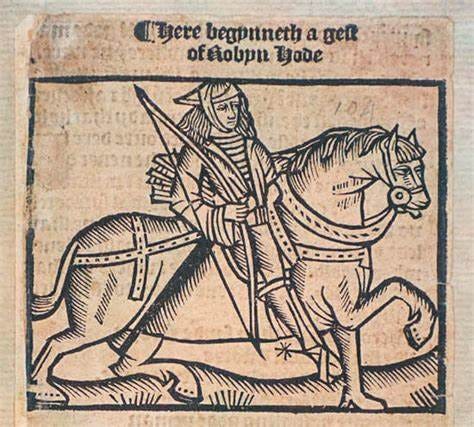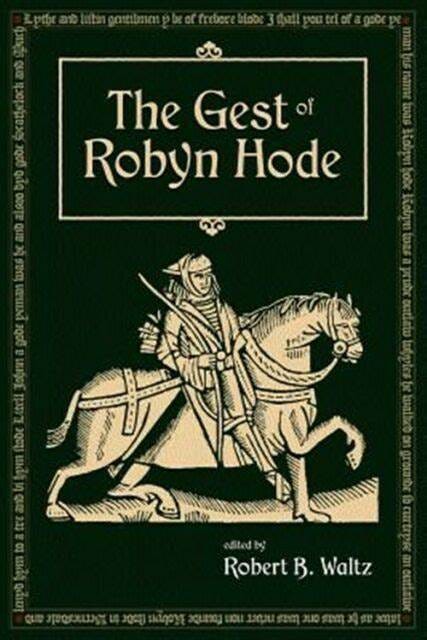ROUD 70: A Gest of Robyn Hode
AKA: A Lytell Geste of Robyn Hode
Steve Roud, the mastermind behind the list through which we are merrily working, is on record as saying that, rather than his original ad hoc approach to adding songs to his index, he wished he had just made the first 306 numbers in the Roud Index a duplicate of the Child ballads. I am thankful he didn’t do that, as in the middle of the Child ballads is an intimidating block of 37 songs all about Robin Hood. I’m very grateful for my regular readers for sticking with me on this journey, but I couldn’t ask them to endure approximately nine months and nearly four books-worth of me trying to think of something new and interesting to say about our favourite tights-wearing wealth-redistributor of yore.
Instead, we only have a trio of Hoods gathered together - this one, and Rouds 71 and 72. Which was a temporary relief, until I realised that this particular ballad consists of 456 verses in Middle English dialect, and unsurprisingly has a very limited history of actually being sung.
However, don’t panic, I have a plan.

Music
Fairly slim pickings to say the least, but there are a few recordings.
Most notably, folk singer Bob Frank updated the language and recorded the entire poem in an American “talking blues” style. The whole album is available on Youtube.
The second most comprehensive take is from Australian folk music enthusiast Raymond Crooke. Raymond recorded his own versions of all 306 Child ballads; as far as I’m aware the only person to have done so, and in a remarkably comprehensive manner. Here he sings about an hour’s worth (before reaching either the technical limits of online video, or his own sanity) to a tune similar to that of Matty Groves (see Roud 52).
From Raymond’s traditional singer/songwriter take, to the oft-overlooked sub-genre of grunge-folk. Here’s a version of the first section of the ballad (that recounts a tale of Robin Hood helping an impoverished knight to erase his debt to a wealthy abbot) from Californian folk rockers bludYodel.
Over on Bandcamp, Louisville psych-funk-rock outfit recorded this instrumental, which I think only has the name in common with the ballad.
Finally, pianist and early music specialist Paul Bracken performed a version for a conference at York University some years ago. Sadly no recording exists, but if you were to book Paul for a piano recital, perhaps you could request it.
Some sources
Scholars of Robin Hood have been quite busy with this epic tale, as it represents some of the earliest and most comprehensive accounts of the legendary bowman’s exploits. As a result there is a huge amount of commentary and research about it (very little of which I have read, to be honest) and much of the subsequent popular Robin Hood-based content now available in the cultural realm is drawn from the events in this ballad.
If you would like to read the full original text, with helpful annotations, it can be found here on the University of Rochester website, and the same website has a useful introduction to the ballad, that carefully and concisely outlines some of the contested notions about the poem and the legend of Robin Hood in general.
One of the most readable and comprehensive guides to the ballad is the 2012 “The Gest of Robyn Hode: A Critical and Textual Commentary” by Robert B Waltz.
It includes a version of the ballad in modern English that is much easier to follow for the 21st century reader, as well as several hundred pages of closely argued analysis and references. Thanks to the magic of the internet, you can read the whole thing here for free at Google Books, thus saving me the trouble of reading it myself.
One of the earliest references to the ballad as a literary phenomenon comes from early 16th century Bible-scholar William Tyndale. Tyndale was into protestant Christianity before it was popular, which saw him cancelled to the point of execution as a heretic in 1536. His greatest achievement was to translate the Bible into a form of English that would have made it more accessible to the layman, rather than the scholarly Latin favoured by the pre-eminent Catholic church of the time. He argued that the Bible’s message was a far better influence than tales such as Robin Hood which were in his opinion “as filthy as the heart can think”. In other words, the ideal source material for folk music:

A similar message came in 1555 from Robert Braham’s preface to John Lydgate’s 14th century translation of the Greek myths of Troy, who dismissed the Gest as “trifelinge tales”:
He also called poems like the Gest “barrayne luerdries”. I’m not sure what that means, nor can I find it in any medieval dictionary, but I’m guessing it’s not good.
Previous star of this series, Bishop Thomas Percy (as seen in the excellent Roud 66) also gives it a mention, also dropping in the now widespread theory that the legend Robin Hood was based on the Earl of Huntington, AKA, Robert Fitzooth:
Finally, you can read Francis Child’s lengthy analysis here.
Draft pages, user guide, and a bit of exciting news
Keep reading with a 7-day free trial
Subscribe to Sing Yonder: A Practical Guide to Traditional Song to keep reading this post and get 7 days of free access to the full post archives.




